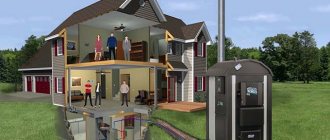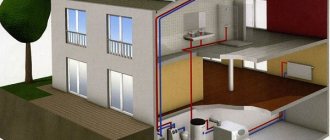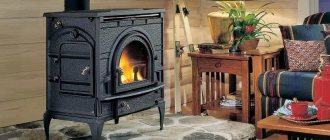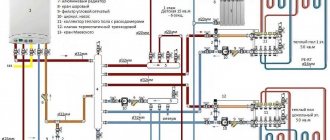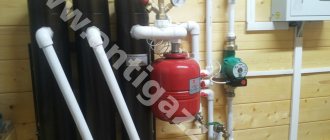Operating principles of combined heating systems
When purchasing a multi-fuel boiler design, which is an element of combined heating, you need to become familiar with the universal power of the boiler device. The area of the building and heating needs are also taken into account here. They consider the most effective and relevant heating combinations, which are based on three principles:
- energy is obtained from all kinds of known sources;
- energy is generated, saved and accumulated, followed by its rational use;
- the system is created both during the construction period and in the completed house.
Combined heating of a country house is a widely used type of heating, because it is very convenient to switch from one fuel to another by changing the burner included in the general set.
Combined heating option in a private house
In this case, no significant changes occur in the settings; all issues are resolved using the instructions. There is one combustion chamber for two types of fuel, so the switching process is short-lived. Technically, this option is considered successful, despite the different fuel prices.
Connection diagram for batteries and one TP circuit
The TP can be inserted into the supply line through a tee. A mixing unit must be installed.
Often heated floors are combined with conventional radiators. Let's consider how to connect a water heated floor to a common circuit if we have only one circulation ring. In this case, we do not need to convert the two-pipe heating system to a radial (collector) heating system. The TP can be inserted into the supply line in the same way as radiators, that is, through a tee. The return line is cut in the same way.
To reduce the temperature to the required level, you need to make a mixing unit. In this case, a pump is not required, since it will be either in the boiler or in front of it on the return line of the general system (after the expansion tank). No flow meters, air vents or other control elements are needed. It is enough to install a three-way thermostatic valve and, of course, like on every radiator, shut-off valves.
Originality of designs
Combination boilers for individual heating of a private home have several fireboxes for different types of fuel. In one of them, solid fuel is burned - wood and coal, in the other - liquid or gaseous fuel in the form of gas or diesel fuel. In such systems, it is possible to connect several autonomous lines and set different temperatures. For example, one supplies energy to the batteries, the other controls heated floors.
For heating a two-story house, this is an excellent option, you just need to focus on the presence of separate heat exchangers, they are not available in every combination boiler.
Scheme of combined heating of a two-story house
The latest developed representatives have built-in heating elements for working on existing energy carriers, and there are also burners that allow you to use both gas and diesel fuel by simply turning the switch to the desired mode. In order to save money and obtain the desired effect of heating a large area, it is worth using a heat accumulator; this is most relevant in boilers using coal. When using solid fuel, the power of the boiler system is not adjusted and the room becomes extremely hot. The heat accumulator present:
- removes excess heat and preserves it;
- If there is a lack of heat, hot water is transferred to the hot water supply or to the system.
With this design, you can turn on the boiler less often.
Insertion into a one-pipe system with an additional pump
This connection option even has its own special name - “Leningradka”. Its use requires installation of a pump and self-assembly of the mixing unit.
In order for the finished system to function without interruption, it will be necessary to take into account the compliance of its parameters with the following requirements:
- the distribution line in internal diameter corresponds to DN25 or more;
- no more than 5 radiators are placed on the ring;
- the heated floor loop is connected to the return pipeline after the batteries;
- the return and supply insertion points are located at a distance of more than 30 cm from each other;
- the degree of heating of the circuit is regulated by a mixing valve (three-way, simplified design).
Layout drawing for underfloor heating and single-pipe heating with radiators
In this system, a valve is necessary to prepare water at the required temperature, and a pump is necessary to move the coolant through the circuit. There is almost no practical use of such a scheme, since it functions unstably, and the radiators lose balance due to changes in water flow caused by the operation of the pump.
Model selection
When starting to select boiler models, you need to know that the power level for certain types of fuel will be different.
House project with combined heating
This is necessary to determine the main type used for heating purposes. One more information - in foreign boilers the rated power is indicated, and in Russian boilers the maximum power is indicated. This will give a significant difference in performance, so you need to be careful. Combination boilers for private homes have different power levels when changing fuel.
First launch of TP
Warm floors are very convenient.
All that remains is to figure out how to turn on the heated floor. The first start can be carried out only after the screed has completely dried - this is about a month. First, the system is filled with water. This is done manually using a pressure test pump or through a pre-installed connection to the water supply circuit.
The technique is as follows:
- all air vents and all shut-off valves open;
- the circuit is filled with coolant;
- when water begins to ooze from the air valves, they close;
- the temperature regime is set at the mixing unit;
- then the boiler turns on.
As the coolant heats up, air will come out of it, so it will need to be vented. After several cycles of heating the coolant, the system will stabilize and you will only have to adjust the hydraulic resistance on different TP circuits using flow meters. As you use it, you will make adjustments to the coolant temperature.
Types of combined heating systems
Gas + diesel boiler
The functioning and operation of this combination depends on the performance of the heat exchanger. Such a representative can be made of cast iron and steel separately or in combination. Consumers using a combination boiler for a private home have become convinced that with a gas pipeline located nearby, it is possible to use both water heating and a combined system in the form of a combination of diesel fuel and gas. This is a very economical version of the acquisition and further operation of the structure.
Gas + solid fuel
Such a system is an independent combination of gas and solid fuel. A multi-fuel device that runs on wood and coal is suitable here.
Boiler for combined heating gas, diesel and solid fuel
This combination is not always effective; the boiler requires the presence of special automatic technology that monitors safety. You need to approach this situation clearly and under the supervision of a specialist, then there will be a return. Despite their complicated design, these devices are popular due to their low cost.
Solid fuel + electricity
Combination boilers for heating a private house with a similar combination are quite often used in practice, mainly in the countryside version. The amount of electricity here is from 220 to 380 volts, the power is 4-9 kilowatts. Potentially there is three-phase switching. While present in the premises, the owners can use solid fuel, and when leaving, the automation is turned on, and the required temperature regime will be maintained in the building.
The price of such a unit, of course, is rather high, but it is reliable and in the absence of other options, this one will be the best.
Gas + solid fuel materials + electricity
Consumers who value maximum power choose only this heating system, which operates with the help of some fuel sources. Coal, wood, coke, and lumber briquettes are used here. A mixed heating system is suitable for different areas located far from the city, but with the presence of a gas pipeline. If there is a shortage of gas or electricity, there is always a way out - to use wood or other solid fuel.
Pyrolysis + electrodes
This device is suitable for heating a two-story house or heating a country house. The combination of the action of a pyrolysis and electrode boiler will allow you to maintain the required temperature, even when the owners are not present.
The scheme is not one multi-fuel mechanism, but two units, and has already gained popularity.
Solid fuel + electric boilers
The combination of a solid fuel and electric boiler will reduce the severity of the energy supply problem. The electric boiler can be turned on at a reduced rate from evening to morning if a two-tariff meter is installed. Firewood is used when it is possible to regularly put it in the firebox and remove the ash. This combination is suitable for houses where there is no gas.
At the beginning of the process it is worth using a solid fuel boiler. After reaching the required temperature, you can configure the system to automatically turn on the electric boiler. As a result, you will get quick heating and save money.
The most popular solid fuel boilers
The ranking of the most famous heating systems is headed by Finnish combination boilers. There is an explanation for this:
- The climate of the country is similar to the climate of Russia, the required power of the heating process can be achieved.
- Manufacturing companies already have extensive experience and capabilities in this area.
- The quality of the models is very high.
Jäspi Group is a well-known company specializing in the production of heating equipment. The boilers have good characteristics; they are equipped with heating elements. Another well-known company is Jäspi. Boilers of this representative:
- operate on solid fuel + gas/diesel;
- they have a copper coil and ceramic grates;
- have autonomous fireboxes;
- stand out for their high efficiency;
Diagram of the Tupla combi boiler from the Jäspi factory - capable of completely burning fuel and are cleaned once a year;
- characterized by small emissions of harmful substances.
The Jäspi Biotriplex line represents the latest model: no switching is required during transitions, the two fireboxes exist independently.
Features of assembling a forced circuit
In order for the forced system to justify itself and function properly, it is necessary to correctly select the circulation pump and correctly “embed” it into the heat supply line.
Selecting a circulation pump
The main parameters for choosing pumping equipment: device power and pressure. These characteristics are determined based on the area of the heated room.
Indicative indicators:
- for houses of 250 sq.m., a pump with a power of 3.5 cubic meters per hour and a pressure of 0.4 atm is suitable;
- in rooms measuring 250-350 sq.m, install the device at 4.5 cubic meters per hour with a pressure of 0.6 atm;
- if the area of the house is 350-800 sq.m, then it is advisable to purchase a pump with a capacity of 11 cubic meters per hour, the pressure of which is at least 0.8 atm.
In a more scrupulous selection, specialists take into account the length of the heating system, the type and number of radiators, the material of manufacture and the diameter of the pipes, as well as the type of boiler.
Installing the pump in the main
The pump is placed on the return line so that the coolant that is not too hot passes through the device. It is possible to install modern models made of high-temperature resistant materials on the supply line.
When inserting the pump, the water circulation should not be disrupted
It is important that at any point in the pipeline when the pumping unit is operating, the hydrostatic pressure remains excessive
Four acceptable schemes for heating systems with pump circulation and an open expansion tank. Hydrostatic pressure is maintained at the desired level
Option 1. Raising the expansion tank. A simple way to convert a natural circulation system to a forced one. To implement the project you will need a high attic space.
Option 2. Moving the tank to a distant riser. The labor-intensive process of reconstructing the old system and installing a new one is not justified. Simpler and more successful methods are possible.
Option 3. Expansion tank pipe near the pump nozzle. To change the type of circulation, it is necessary to cut off the tank from the supply line, and then connect it to the return line - behind the circulation pump.
Option 4. The pump is included in the supply line. The simplest way to reconstruct the system. The disadvantage of the method is unfavorable operating conditions for the pump. Not every device can withstand high temperatures.
Boilers from other manufacturers
The most popular combination in a multi-fuel boiler is: solid fuel + gas.
This is what Zota combi boilers look like
This makes it possible to perfectly heat cottages near which gas mains pass. Along with Finnish boilers, there are also Polish ones from Zota. They can combine solid, gaseous and liquid fuels. However, the burner will need to be replaced. The price of the boiler is low, this model is suitable for those who do not intend to change energy sources often.
For those who want to regularly change fuel, a combined double-flow boiler from Zota - ECO CK Plus is suitable.
The scheme of work here is different. The main solid fuel runs out, and another burner is switched on automatically. Everything is fixed in the settings. This is an interesting model of a multi-variant boiler, but it also has disadvantages - size and cost. Other existing models:
- Finnish Jäspi Triplex and Swedish CTC represent a combination: gas + solid fuel + electricity, and there are also examples: diesel fuel + gas + firewood + coal + electricity;
Drawing with dimensions of Finnish Jäspi Triplex boilers - Czech cast iron combi boilers DAKON FB operate with pellets;
- Finnish boilers Jäspi VPK operate with pellets, gas, diesel fuel, wood, coal, there is an electric heating element;
- Austrian combination boilers Wirbel Eko Sk Pellet Pus have two fireboxes;
- Russian combined boilers "FAX" work on wood and coal, there is a heating element;
- The Russian combined boiler “Dymok” runs on wood or coal.
Option 4: air source heat pump + wood
Device
This scheme was implemented in the neighboring house. A heat pump operating according to the “air-water” scheme is used as the main heat source: the external unit takes heat from the surrounding air, the internal unit transfers the resulting heat to the coolant (water in the heated floor circuit). An additional source of energy is a wood-burning fireplace with a water jacket around the firebox.
Diagram of connecting a fireplace to a water heating system at home.
Advantages
A heat pump is more profitable than any direct heating device (including an electric boiler): it provides an effective efficiency of ... 200-500%.
Excuse me, but how is this possible? After all, the efficiency, by definition, cannot be more than 100%, right?
The fact is that the device is not a source of heat. It only pumps it into the house, taking it from a low-potential (read - heated to a lower temperature compared to the heated room) source - the external environment. Electricity is spent only on the operation of the compressor, which circulates the refrigerant.
When a heat pump operates, the source of most of the energy is the external environment.
Heat pumps have two common features:
- Relationship between efficiency and temperature at heat exchangers . The appliance's COP (a parameter describing the ratio of effective thermal power to electrical power) falls as the temperature difference between the evaporator and condenser increases;
Dependence of the COP of a heat pump on the temperature of the heat source medium at a constant temperature inside the house.
- Evaporator (external heat exchanger) temperature limitation . The pump cannot take air from a medium with a temperature below -25 °C. The limitation is associated with the temperature at which the state of aggregation of the refrigerant changes.
For an air source heat pump this means that:
- As the weather gets colder, the cost of heating your home will rise, both due to increased heat loss and lower COP;
- At -25 °C outside you will have to use another heat source.
This is where an additional heat exchanger in a fireplace, stove or solid fuel boiler comes to the rescue. Connected to a common circuit with the heat pump, it helps it heat the coolant, and in severe cold weather it completely takes over the heating of the house.
During severe frosts, the house switches entirely to solid fuel heating.
Independent heating of the house
The variety of existing equipment makes it possible to arrange the heating of a private house with your own hands; the owner must have the appropriate knowledge. Now living outside the city has become a priority; hot water is available around the clock, heating is turned on at the request of the owners at the right time. But everything needs to be arranged correctly, otherwise a comfortable stay will be impossible.
Existing schemes of combined heating boilers
Before installing a system for any room, especially heating a two-story house, a project must be drawn up, which is certified by the relevant organizations. If you install a boiler with gas equipment, you will also have to tinker with documents and connecting the gas main.
An important point is the fact that in private houses heating systems consist of upper and lower wiring using vertical and horizontal elements. In a one-story house, it is best to use an upper distribution with the presence of a main pipeline in the attic, and for heating a two-story house, a lower one is usually used with a boiler in the basement.
Video review of the boiler room of a private house with combined heating. For proper installation, you need to stock up on a certain set of tools. Definitely, a combined heating system for a private home is a wonderful discovery for owners who have problems with heat resources. Modern boilers can use a variety of fuels - this depends on individual decisions. Each type has its own disadvantages, but with successful combined solutions you can achieve the desired results and install a suitable and effective heating system for your own home.
What we combine
Within the same house the following can function alternately or simultaneously:
- Different heat sources (usually boilers using different types of energy carriers) connected to a common heating circuit;
- Two or more completely independent heating systems . They can divide the house into several rooms heated in different ways or, if necessary, replace each other throughout its entire area;
- One heating circuit with two or more types of heating devices.
Now let's move on to studying samples of such heating systems.
A little background
The very idea of insulating floors, as well as walls, by laying hot water pipelines inside them is by no means new. Back in Soviet times, experimental projects of panel houses were created and implemented, in which hot water circulated inside the floor slabs and walls, thereby providing apartment heating without radiators. It was believed that the absence of batteries saves useful space in rooms and does not spoil their aesthetic appeal.
Connecting a heated floor to a heating system
It is quite natural that such buildings have not stood the test of time, due to the almost zero maintainability of heating systems and extremely low economic feasibility. Indeed, most of the heat was not spent on heating the interior, but went to heat the structural elements of buildings and the surrounding atmosphere.
Channels made of iron corroded very quickly due to constant contact with water under pressure and at high temperature.
This publication is devoted to a description of floor heating systems combined with heating communications, as well as consideration of the nuances of installing heated floors.
